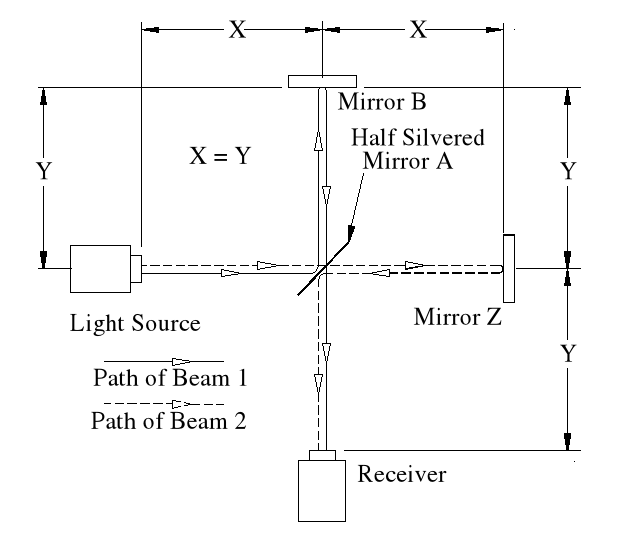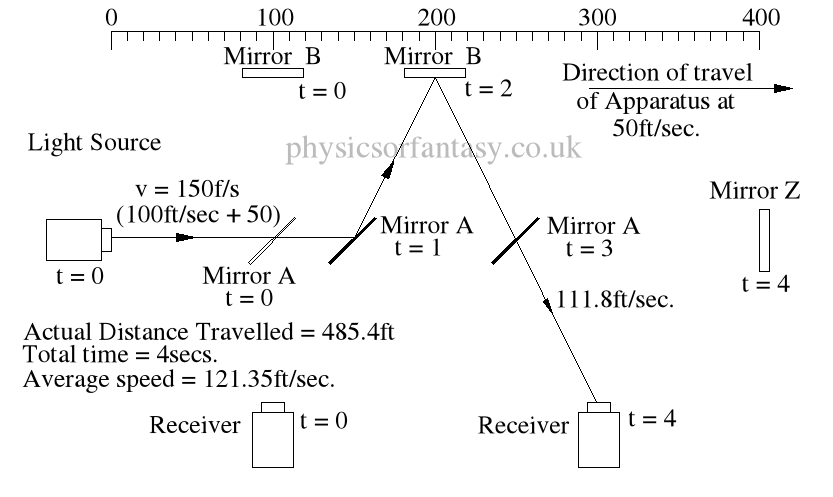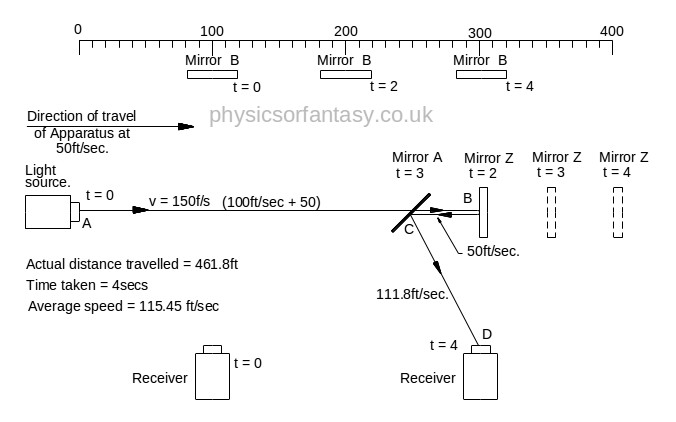-
The Full Mathematics of the Michelson – Morley Experiment. Part 1
Posted on November 28th, 2014 No commentsI have never understood why the physics establishment decided that time differences were relevant to the Michelson – Morley experiment. I first looked at this about 48 years ago and my first thoughts were that there could not be any time differences. I am now absolutely certain. The actual results obtained from the experiment are exactly in accordance with the laws and mathematics of classical mechanics.
Basic Set-up of the Experiment.
The idea behind this experiment, dreamed up by Michelson & Morley, was that somehow it would enable them to detect the motion of the Earth in space, (or relative to a fixed point in space), and that it could be detected by differences in the time taken for two beams, travelling different paths, both identical in length. No differences were observed. Note that the physicists assumed that the path lengths were identical. This was the first major error of the Michelson-Morley experiment.
Unfortunately, the experiment (in 1897) was doomed to failure, because the mechanics of it were not understood by Michelson & Morley, (or any later physicists.)
Summary of Actual Mathematics and Mechanics.
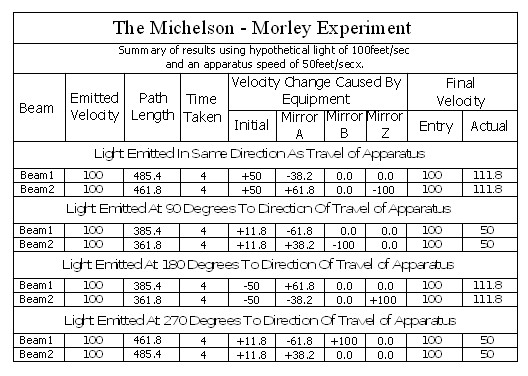
Note; This is simply an experiment in mechanics, and therefore all the laws of mechanics must be strictly adhered to.
In the above chart ‘Emitted Velocity’ means the velocity that the light travels away from the light source.
Let us consider that the apparatus is travelling in the same direction as the light is emitted. Let us assume that the speed of light is 100feet/sec, and let us assume that the apparatus is travelling at 50feet/sec. I do this because using the actual figures leaves us with messy figures such as;
” T2 = (2 x 0.1 x 300,000.0015/300,000) x (1/300,000.0015)” – From Physics or Fantasy – Section 1. (It would also be difficult to get figures like this into the chart above.)
Beam 1
Within the apparatus the light would travel a distance of 400 feet in 4seconds, travelling from the emitter to Mirror A, then on to Mirror B and then passing through Mirror A again until reaching the Receiver.
However, whilst this is happening, the apparatus will have travelled 200 feet up the laboratory at a velocity of 50feet/second in the same 4 seconds.
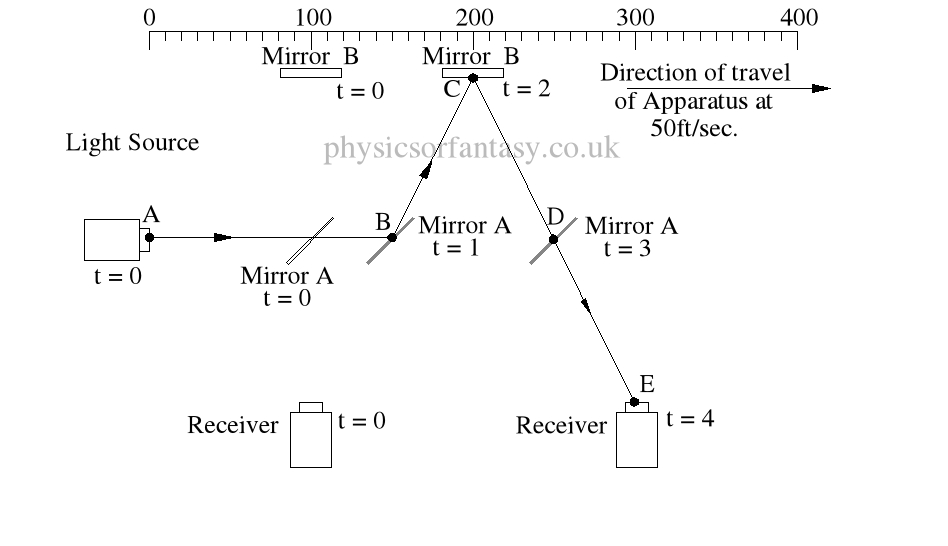 Ignoring the speed of the light and considering only the speed of the apparatus, the light must pass through the points B, C, D and E, after being emitted from point A, and at the times stated. The distance the light must travel to pass through these points is 485.4 feet. If the apparatus is moving at any speed relative to any point outside the apparatus, then the distance travelled relative to this external point must be greater or less than the path length within the apparatus, in our example 400 feet.
Ignoring the speed of the light and considering only the speed of the apparatus, the light must pass through the points B, C, D and E, after being emitted from point A, and at the times stated. The distance the light must travel to pass through these points is 485.4 feet. If the apparatus is moving at any speed relative to any point outside the apparatus, then the distance travelled relative to this external point must be greater or less than the path length within the apparatus, in our example 400 feet.The light is emitted at time t = 0, and must arrive at point E because that is where the receiver will be at time t = 4secs.
The velocity of the light relative to its starting position (Or even a fixed point in space) will be 100 ft/sec emission velocity plus 50ft/sec (the velocity of the apparatus), but only until it strikes Mirror A.
Because Mirror A is moving away from the light, and is at 45° to direction of travel, the reflection of the light is, (according to the laws and mathematics of classical mechanics.) reduced to a velocity of 111.8 ft/sec. In other words the actual velocity of the light is reduced by 38.2 ft/sec.
Anyone who plays tennis, cricket, table tennis etc. will understand why this happens, without needing a degree in physics. A batsman facing a 100mph ball has various options. He can play a forward forcing shot (which will increase the speed of the ball) over the bowlers head, hopefully, for six runs. He can also move the bat backwards at the time of impact, which will reduce the speed of the ball. In both situations the angle of the bat also affects both the speed and direction of the ball.
Mathematics
Va = Velocity of Apparatus.
Ve = Emitted Velocity of the light.
mA = Mirror A, mB = Mirror B, mZ = Mirror Z.
PD = Physical distance between items of apparatus, example: PD(E>mA) = physical distance between emitter and Mirror A. This is 100ft in all cases in these examples.
TD = Travel distance of light between leaving one item and arriving at the next.
E = Light emitter.
R = Receiver.
Note: It is irrelevant whether you use feet, metres, miles, kilometres or Mega-miles as your units of measurement, if you remember to be consistent. This post is designed to investigate the validity of Einstein’s mathematics and logic.
Beam 1 – (E>mA)
This is the simplest part of the mathematics.
If the light is emitted at 100ft/sec. and the apparatus is travelling at 50ft/sec then the light must travel at 150ft/sec.
In 1sec. Mirror A will have travelled 50ft from a position 100ft in front of the starting position of the light.
In other words, in 1sec. Mirror A will be 150ft away from the starting position of the light.
If the light travelled a a constant speed of 100ft/sec, it would take 1.5 secs to arrive at the position that Mirror A was after 1 sec. However, it would still be 25 feet behind Mirror A.
Time taken from Mirror A to Mirror B.
Tan A = Actual distance moved by Mirror B, divided by the physical distance between Mirror A and Mirror B.
Tangent A = 50/100 = 0.5. Angle A is therefore 26.565°
TD = Cosine 26.565° = 100/X = 111.8 ft.
It must travel this distance in 1 sec. otherwise it it would miss mirror B. ( Note; Although the mirrors in my diagrams are shown as very wide, in actual practice the mirrors would be narrow, probably about 0.5 inches (12.5mm) wide).
The actual distance travelled by the light from light source to Mirror B is now 150 + 111.8 = 261.8ft. It has taken 2 seconds.
The light now has to travel from mirror B to the receiver R. The actual distance between mirror B and the receiver R is 200ft. However, the light has to travel a distance of 2 x 111.8 to arrive at receiver R.
It takes 2 seconds to travel this distance at a speed of 111.8ft/sec.
TD(E>R) = TD(E>mA) + TD(mA>mB) + TD(mB>E) = 150 + 111.8 + (2 x 111.8)
= 485.4ft
The average speed of the light is 485.4/4 = 121.35ft/sec.
It should be obvious that over a period of 4 seconds the light must strike mirror A then Mirror B, then Mirror A again, and finally the receiver R, at the times shown because that is where the items are at the times shown. The light beam must travel at the speeds shown to allow it strike the items.
Beam 2.
Beam 2 travels from the emitter E to Mirror Z, then back to Mirror B and then onto the Receiver R.
The path length (measured on the equipment) is 400ft.
Note: The light strikes mirror Z at a closing velocity of 100ft/sec, because mirror Z is moving away at 50ft/sec. The light reflection loses another 50ft/sec. because the mirror is still moving away at 50ft/sec.
The speed of the light reflection relative to mirror Z is 100ft/sec. Confusing isn’t it? But it is true. Cricketers, table tennis players, etcetera all use this fact whilst playing their games, and without a honours degree in physics or engineering. Although not an everyday problem in mechanics it does arise quite often in machinery design.
TD(E>mZ) = Time taken from Emitter E to Mirror Z.
= TD(E>mZ)/V2(E>mZ) = 300/150 = 2 sec.
DT(mZ>mA) = Time taken from Mirror Z to Mirror A.
= TD(mZ>mA)/V(mZ>mA) = 50/50 = 1 sec.
T(mZ>R) = Time taken from Mirror Z to Mirror A.
= T(mZ>R)/V(mZ>R) = 111.8/111.8 = 1 sec.
—————————————————
Notes on lack of time differences in the Michelson – Morley experiment.
If you place the experiment on a train and rotate it through 360° and measure the time taken for the light to travel from the emitter to the the receiver at various angular positions, no time differences will be detected.
——————————————–
If you are in a car travelling eastwards towards the rising Sun at a road speed of 100 mph, then your speed relative to the Sun (It being a ‘fixed point in the universe relative to us), would be approximately 1,100 mph. (The earth rotates at approximately 1000 mph.)
If later the same day on the same road and still travelling at 100 mph, but travelling in a westerly direction towards the setting sun, your speed relative to the sun would be approximately minus 900 mph. Therefore your speed relative to the sun would have changed by 2000 mph, (i.e. from +1100mph to -900mph.) in the 12 hours between the two journeys.
——————————-
If you replace the car with a beam of light and carry out similar timings the light will actually be travelling at c + 1000 mph when travelling towards the sunrise, and c-1000mph when travelling towards the sunset, ( c = The claimed constant speed of light.) The velocity of the light (Relative to the Sun) changes by 2000mph between these
Let us change our apparatus to a tube 300,000 kilometres long (approximately). Inside this tube there is a light transmitter(A) at one end and a light receiver(B) at the other end. We set this tube travelling towards the sun, with end B at the leading end, at a speed of 300,000 kps. When B is at a distance of 300,000 kilometres from the sun we fire the light emmitter at A, towards B (the receiver). One second later end B hits the sun at exactly the same time as the light hits (B). At the time (A) is triggered it is 600,000 kilometres away from the sun.
During this one second the light has travelled 600,000 kilometres and this light has travelled at twice the speed of light!
If we had reversed the tube so that A was at the front end and carried out the same procedure, the light would travel from A to B in two seconds. (end B is still 300,000 kilometres from the sun when end A hits the sun). The light still travels the length of the tube in one second but to an outside observer the light front would be static whilst the end B would be travelling at 300,000 kps towards the light front.
It is this aspect of the Michelson – Morley Experiment that confuses the physicists (plus one or two trigonometry mistakes.)
The man plus the train, the car plus the road, are just different versions of the Michelson – Morley experiment.
Author – Brian Williams
-
Basics of an Atomic Theory
Posted on July 16th, 2010 No commentsThe construction of an atom model that satisfies all the requirements of scientific knowledge regarding both physical and biological facts must be our starting point. It must be able to explain colour, weight (mass), state (i.e. solid, gas or liquid), changes due to temperature, changes due to pressure, hardness, and softness, rigidity and flexibility, chemical reactions, gravity, magnetism, and most importantly, life.
The physics establishments ‘hypotheses’ do not explain any property of matter therefore they do not qualify as theories.
My atomic theory explains all known properties of matter. (It therefore passes the requirements of a theory.)
I may be wrong, but certainly not as wrong as the Physics Establishment.
The reader will have problems due to fact that I go against all the current atomic hypotheses that he/she will have been taught or accepted. I can understand this because I had the same problem myself, many times over the years finding it difficult to believe my own results. Eventually it was easier to consider existing hypotheses only to pinpoint where the problems were. This was a case of selecting any particular hypothesis proposed by the physics establishment, assume it is wrong, and work out alternative hypotheses and then produce a working theory. 90% of current hypotheses cannot even satisfy the title of theory because there are no explanations of how they could work.
One of the main reasons for physicists opting for whizzing high-speed electrons is an attempt to explain the energy of an atom.
However, all energy is stored in one of two states, momentum or stress. (Occasionally it is stored as a combination of both)
The energy of atoms is stored as stress.
The reader may find this statement difficult to accept but it is true, whether you are considering chemistry, radiation, mechanics or biology. However, if you ask a physicist to explain how his model/hypothesis of the atom explains any of the physical or biological facts of reality, he will only mumble that you will not understand the explanation, being a mere mortal, but will then brighten up and go into the fantasy world of physics in the form of time dilation, rubber sheet universes, black holes, time travel etc. things that are basically fairy stories to amuse the public.
Can you remember anything produced from physics hypotheses? Forget atomic energy which was a discovery by SCIENTISTS not PHYSICISTS. The physicists were brought in to attempt to find an explanation, with which they are still struggling. The atom bomb and controlled atomic energy were produced by scientists and engineers, with the physicists hanging about trying to look important. Note; We have atomic energy not nuclear energy.
What we consider to be atomic energy is only another step along the way from rubbing two sticks together to create fire, energy from coal and gas, dynamite, all of which are atomic reactions. The Atom bomb and its derivatives are toys relative to the energies that could be released if we inadvertently hit something that is a lot more stressed than the radioactive materials that are being used today. Radioactive ‘elements’ are already breaking down and are unstable. The more dangerous elements will not show this breakdown, and we will not be aware of their danger until too late. The pointless experiments with the so-called Hadron collider will not produce any useful knowledge, but could inadvertently blast a huge hole in the centre of Europe
From Section 3, Physics or Fantasy
-
Wave Theory – Problems
Posted on May 16th, 2010 No commentsShort abstract from Physics or Fantasy – Section 2
One of the main problems with the physicist’s interpretations of ‘Wave Theories’ is that the complications of acceleration and deceleration are ignored. No-one has ever measured the ‘wave-length’ of sound, radio waves or light, even though wave-lengths have been quoted for radio waves for the last 100 years. Even the wave-lengths of water waves are difficult to measure.
The wavelength of a single note emitted from a speaker increases (within certain limits depending on the substance through which is travelling) as the sound travels away from the speaker, but the frequency remains the same. The initial wave-length depends on the speed of the speaker cone, (which also has an acceleration and deceleration), the ambient air pressure and the distance the cone travels (which also varies as parts of the cone travel different distances). Electrical waves have even more serious complications that are never considered by the physicists.
These problems also apply to water waves which means that the standard formula Wavelength = Speed divided by Frequency is a very loose formula which should have careful consideration before being applied in any situation. Unless you understand the mechanics of the problem that you are considering, you should avoid applying any mathematics.
The physics establishment’s haphazard use of the formula causes many problems, one being the serious misuse of it in the Mossbauer Experiment. Mossbauer got a Nobel Prize for this work in 1961. This has created all sorts of silly hypotheses relating to crystallography which have hampered real physics ever since .
Wave Mechanics or more realistically ‘the mechanics of waves’ is a subject that the physics establishment have very little understanding of, yet happily bring it up in discussions, usually in the form of ” but that relates to wave mechanics, which you will not understand”.
Author – Brian Williams
-
Basic Principles of Research
Posted on June 26th, 2009 No commentsPhysics is the knowledge of how things work in the universe. This includes both non-biological and biological knowledge. Our knowledge is obtained through our 5 basic senses, plus extensions to these senses such as telescopes, microscopes, stethoscopes etc. The information from the senses is then passed through to our brain to work out what it all means. Therefore all research depends on our senses.
Eyes Seeing Ears Sound Nose Smell (Chemical Analysis) Tongue Taste (Chemical Analysis) Skin Touch(Pressure), Temperature The most highly developed of our senses is seeing. Physicists often refer to the unseen world of the atom, yet the brain depends on the eyes ability to detect particles much smaller than the atom, i.e. sub-atomic particles, to give us our sense of sight.
Smell and Taste can differentiate atoms and molecules, in some people to a very high degree of accuracy. Many people operating within the chemical industry can accurately determine some chemicals by taste to within 1 part per million. Many creatures can do far better than this, being able to detect 1 part in many billions. The dog can detect dispersed scents (Smell) after many hours and over many miles, and the shark can detect blood components (Taste) from many miles away.
Research
There is a normal method of carrying out research which is based on experience and common sense.
- Accumulation of information.
- Analysis of information.
- Deduction.
In modern physics step 2 is almost always ignored, and has been replaced by the application of mathematics. The most well known by the public of all modern physics subjects is Einstein’s e = mc2, the deduction from the information accumulated from the Michelson-Morley experiments. The experiments were straight mechanics problems, with the results obtained deducible without the use of any mathematics. Unfortunately the physicists do not understand mechanics, and even applied the wrong trigonometric formulae.
Consider this extract, proudly proclaiming the great strides in physics.
“Firstly, the abandonment of the ideal of a mechanical explanation of everything has eliminated a great deal of idle hypotheses. The properties of the fundamental entities of physics are now stated in the form of mathematical equations, instead of being ‘explained’ by a hypothetical mechanism.” From ” The Philosophy of Physical Science”, by Sir Arthur Eddington. This is the ‘Eddington’ usually quoted by physicists when they are asked awkward questions.
It is clear from the above passage that not only do physicists not understand mechanics, part of their catechism is that mechanics should actively be ignored in favour of mathematics.
Note, I have been involved in mechanics all my life, but I have never come across a ‘hypothetical mechanism’. As an engineer I only deal with reality, and the main role of engineers is to understand how things work. Analysis is the mental process that the human brain uses to arrive at an understanding of any problem. Whether you are considering crossing a busy road, deciding what to have for dinner, considering the best way to operate on an injured patient or how to find your way home when you are lost, are all examples of analysis. Mathematics is never involved. Analysis is based on our knowledge (accumulation of information) and the relationship between individual bits of this information.
Modern physics now operates on the ‘Black Box’ principle. If you have something going into a black box and something else coming out, it is extremely easy to find or construct a formula to match the in-goings and outgoings. However, no formula will ever tell you how the black box works, or is constructed. You need an in-depth knowledge of mechanics to do this, even if dealing in biology, chemistry or physics.
The analysis of information must include the following:
- Is all the information pertinent?
- Does any apparatus used have any effect on the information (a crucial area for serious errors)?
As a child of 5 or 6 years, I was in possession of 2 items of crucial scientific importance, and also a fine laboratory. The fine laboratory was a cinder covered field directly in front of our house. that was half full of garages. This field sloped, and in rainy weather, the rain gouged little rivers and created ponds that fascinated us children. If any physicists had ventured into our laboratory and asked us how waves are created all of us would have given the same answer, which was “By the pebbles we dropped into the ponds, and by the sticks we poked into the streams“, the two items of crucial scientific importance that I refer to. The pebbles and sticks are items of apparatus that seriously affect our observations, just as the prism and lens affect our optical experiments.Even as children, although we believed in fairies, Father Christmas, and ghosts, we would not have been gullible enough to accept the argument that by dropping a pebble into a pond we were magically seeing the wavelike nature of the still water, or magically seeing the wavelike nature of a steady flow of water, as seen when putting a stick (Magic Wand?) into it.Modern physics is full of people who demonstrate a naivety far greater than most 5 or 6 year old’s. The implications of the above 2 simple (childlike) experiments require an understanding and knowledge of mechanics that modern physicists just do not have.Physicists still do not understood that their ‘evidence’ for the Wave Theory of Light’ is entirely an illusion created by their apparatus, in a similar manner as our childhood playing with water. The waves created in water by the apparatus do not prove that water itself has a waveform or frequency. The waves created by the apparatus in optical experiments do not prove that light itself has a waveform or frequency.If the number of people entering a store was plotted against time, the plot could show a sinusoidal waveform. This would not prove (at least to me) that the individual people had a waveform or a frequency.See Physics or Fantasy – Section 1 – Light and Relativity.Brian Williams – Author


